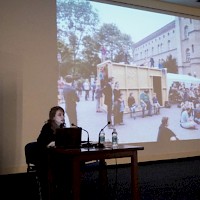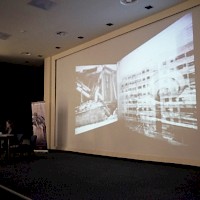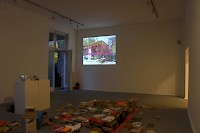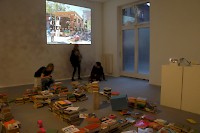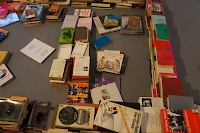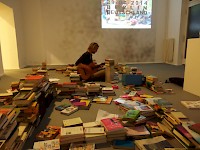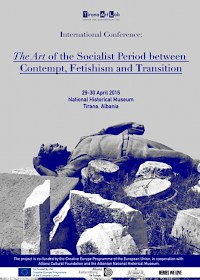OPEN MONUMENT CONFERENCE TEXT
MARTA JECU and JOSE MANUEL GOMES PINTO
My planned contribution to the Tirana Art Lab is centered around a book that I have edited called OPEN MONUMENT (Revolver Verlag, Berlin, 2013) and which was associated to a number of artistic interventions in public space, performances and an exhibition in Berlin at Kunstraum Kreuzberg Bethanien.
The project and book were meant to discover what happens with the information contained in fallen monuments, as a consequence of political upheaval. The project was based on a number of case studies, localized in areas of recent or past political turmoil, like Romania, Berlin and even Angola, Portugal, Japan – monuments that the artists themselves chose. The main challenge was to suggest ideas of non-symbolic monuments.
Anthropologists, curators, architects were invited to analyse the context around an already disappeared or decaying monument while a number of 12 artists were proposed to built a new work with this historical material: a non-symbolical, ephemeral, accessible, functional counter-monument connected to these case-studies.
I will start with some theory on monument that was inspiring this project
THEORY
This project is indebted to James E. Young and the books reprints one of his articles. James Young, scholar on Holocaust memorials, coined the term ‘counter-monument’ to describe the intentional diversion by contemporary artists from traditional memorials. Counter-monuments are usually abstract pieces, meaning they hold no discernible form and do not directly seek to represent an image or message. Counter-monuments are usually not aesthetically pleasing, some are not permanent; others encourage people to write on them, though all are meant to engage their viewers, often uncomfortably, in acts of personal remembrance and individual understanding of historical events. This form of personal engagement to reshape a society’s collective memory based on a decentralized process of recollection reflects the concept of ‘traumatic realism’ for many Germans. Counter-monuments attempt to recall the past through a production of it, forcing viewers to develop their own role and disposition toward their ‘post-traumatic culture’.
- The monument has in general a very hybrid identity, on one hand it is a functional object, on the other hand it is an artistic/aesthetic/ so not primarily utilitarian object. As a functional object it is erected with the purpose of commemorating and it is doing so by concentrating in a symbolic way a historic and narrative content.
As an aesthetic object is essentializing and exhibiting a certain aesthetic trend, a political or social credo or a political ideology with the tools of the art than contemporary. In this sense in both cases it is an instrument that brings a certain content into the present and into the immediate consciousness of the citizen.
The monument is also creating a geographic demarcation. It is marking by its presence the center of a territory, while becoming a container of social projections. The monument is thought as a tool for communication, but it nevertheless most often closes and petrifies content. An efficient monument should be one that changes its identity, while absorbing and generating constantly a new content for always different people. In this way it should be conceived as a permeable structure that makes it possible that it responds to the quotidian.
- I will here enter into some theories of the monument, that uncover and demask the political agency of monuments especially in repressive systems. I will than pass over to theories of the 'new monument', which try to establish a new approach to the monument, after its failure and the necessity to systematically destroy and efface monuments of previous eras.
In his Posthumous Writings of a Living Author, published in 1936, Robert Musil talks for the first time about the traumatic effect of monuments. Robert Musil1 talks about the fact that monuments reject what they are supposed to attract: the gaze – and elude our perceptive faculties. This happens due to their monstruous character. Musil talks the quality monuments have to be ‘impregnated with something that repels attention’, of being refractory even to reason. We actually can remember that even for us, the inhabitants of communist architecture cities in the Eastern Block, the infinite rows of apartment blocks, the equal streets and shops, the rests of old houses mutilated by forced demolitions and evacuations were indeed almost not perceived by us any more. The massive character of these abusive alterations on the level of the city and especially mass demolitions, desolated factories and all encompassing standardization, end up having this almost imperceptible character, although they are more than obvious. These monuments of communism are always there, but cannot be looked at due to their monstruous and un-assimilable character. They cannot be totally understood in their grotesque appearance. Therefor they become completely immersed in the repressive political system they stand for. Another interesting example is the Berlin Wall, erected to remind of an impossible political reconciliation. Citizen on both sides were constantly coming up with astonishing inventive solutions to look over the wall '- in order to be able not to see the wall. From timely testimonies we find out that the Wall itself dissapeard from the visual consciousness: it was hardly looked at..
This phantomatic character of monuments results also from a case study presented in this book which is dedicated to industrial wastelands and fences in Romania, by Liviu Chelcea. The massivity and excessiveness of factories in the middle of Romanian cities, contributes to the fact that what remains visible at the level of urbanity from these factories and urban industrial lots, are their encircling fences. For Chelcea fences are some of the most dynamic public objects in Bucharest. They show the recent property rights transformations, which included re-appropriation and privatisation. Fences perform a communicative function. As factories went bankrupt after the fall of communism, or await demolition, it is the fences that generate a new ecology. As border to the rest of the city, they are the only communicating element and they become a source of raw materials: scrap metal and bricks or wood for heating are stolen and recicled. Constantly the factory itself dissipated simply from urban consciousness giving way to new forms of re-teritorialization. Nevertheless this slow death of industrial monuments (both 19th century factories assimilated by the communist regime or communist plants) meant also an unperceived decomposition of these monuments, without their transformation or progressive disappearance being documented.
the monument can be thought and we tried to understand it in this project, not only as a large scale public construction, but also as fetish- object of commemoration. Stephan Bauer one of the authors in this book, talks about the processes of self-historicisation that take place especially in Germany, as an urge to deal in a most effective and often artificial way with the traumas left by the wars and the national socialism. He describes that a consequence of these forced processes of self-historicisation (meant to pardon and exorcise) is the 'memorial kitsch'. In this sense, we can talk about commemoration policy, which should be an important concern in cultural policy. At the time when this book was issued, there was a very strong debate going on in Berlin regarding parts of the East Side Gallery, a large part of the Berlin Wall, which was covered in graffiti. For having access to the river side (which is immediately after the Berlin Wall), big investors and construction companies bought from the state parts of the Berlin Wall, which they destroyed in order to have access to the waterfront for their planned buildings which meant a major loss of cultural, historic and political patrimony. In this sense Stephane Bauer argues that public space with its traces left by history should be understood also as a public monument. Thinking about Berlin with its contemporary cultural variety, we can than think of ways to conceive its public space as a vibrant and contemporary monument, that should be constantly be allowed to change its face.
Another necessary distinction is that between the monument and the museum. While the museum has been historically supposed to conserve meaning and demonstrate an ideological continuity in time, a monument can be conceived now – with the involvement of contemporary art– as a permeable structure, that, unlikely a museum, changes content.
In new museum studies, the accent is put on a new type of monument, that should be able to prevent the museification of historic narrative. In this way the monument can be thought of as a 'model' / a 'maquete' of public space, an entity invested with certain functions and that can be filled with different content, according to present social necessities. A museum is creating a visible hierarchy of the exhibited items, according to their material and cultural value. We have been used that in the social past, political monuments affirm and abusively impose upon the viewer a hierarchy of importance: more important public figures than other, more important spots in the city as others, or more important historic events than others. On the contrary a public monument, should facilitate access to a shared social experience, in the lived reality.
Robert Smithson wrote about the fact that ‘information, and that includes anything that is visible, has its entropic side’. The book insisted mainly on this other defining characteristic of the monument which is its entropic side. The project was actually focused on working with the time after the monument.
THE ARTISTIC CONTRIBUTIONS to this project were meant to make an attempt of mutating the course of the almost unavoidable museification or dissolutions of particular monuments. For example they pay attention to the migration of historic forms: Paula Nascimento, an Angolan architect and anthropologist maps the persistence/imposition of modernist colonial architectural forms on the vernacular architecture in Angola during the Salazar time.
I will show a few more examples of works - attempt to bring the historic and architectonic information contained in the fallen monuments back into movement. The connecting principle between these works was Tto imagine and make a monument 'work': one that does not commemorate, that does not have a symbolic form, and that is not a container of stored meaning, so is therefore one that is not coercive. Smithson even writes about an instant monument: - in time and space: one that is going nowhere, that doesn't occupy space. This is the monument that brings past and future together.
The work of Delio Jasse is to insert in the public space of Berlin a large visual library with prints, that represent an inventory of these architectures The citizen can stop and consult the archive. He also constructed inside the gallery an immersive installation where different layers of projections of superposed architectures were actually giving the impression of the transformation fo the city.
Sinta Werner, who constructed two distorted models of the architecture of the Kreuzberger Center (the so called Neues Kreuzberger Zentrum), which was designed by Johannes Uhl and started being functional during the first years of the 1970s. She photographed them in situ by superposing the actual architectures with the models, that oscillate between an unaccomplished form and a formalism specific to architectural futuristic projections. As in her overall preoccupations, Sinta Werner uses these 3D collages scenographically, switching between the actual architecture with its specific tectonic qualities and its potential to become totally de-natured when transferred into another medium.
Territorial demarcation lines or construction that demarcate territory were also understood as monuments. Three of the artists work with the Berlin Wall, denoting its persisting presence in a common European imaginary, while both converting its reason of being: Sancho Silva and Christian Troberg bring the Berlin Wall into movement and traverse the new Berlin with it, while Cristian Rusu builds from its segments what he calls a Pavilion of Melancholia, a interchangeable structure, that functions in various architectural formations as an open urban abode, in which the passers by can rest, meet, think and be protected from the urban tumult. Modernism and the architectural form that can be brought into oscillation are constant preoccupations in his work. This ephemeral and mobile miniature labyrinthe with a modernist aesthetic, which can be placed anywhere in the city, has a mainly meditative functionality, determining historic associations, but also provoking a contemplative mood, which can open the heavy loaded symbol of the Wall, until it reaches an almost pop presence. The insert of Cristian Rusu Rodchenko For Public Space - Rodchenko by Rusu, 2013 is another proposal of abstracting the historic statement of a modernist form (in this case the constructional studies of Rodchenko) and projecting them as contemporary architecture. Yukihiro Taguchi and Chiara Ciccarello constructed in the winter of 2013 manually and with recycled material a small house on the empty lot at Cuvry Street in Berlin ('Dis-Cuvry' project), where they started living and who's functionalities they extended for the needs of the settlers and occupiers on the lot. The architectural project intends to compound into its substance extrinsic factors, that are normally left outside of the walls of a house: the ambiguous legal status of this lot, with its negociated borders, the low temperatures in which the artists worked, the input of the socially radical nucleus living on the site and the urban abandoned material which carries its own history, which all converged into a prototype of house as an immediate consummation of the conditions from which it emerged.
Matias Machado has made a monument to one of the key figures of the anarchic movements initiated in the 1960s in West Berlin: Fritz Teufel, a friend of the artist that passed away 2010. Machados work in the OPEN MONUMENT exhibition documents his own apartment in the Berlin Groeninger Straße 50, where Fritz Teufel has often been guest. In front of the Kunstraum Kreuzberg/Bethanien in Berlin Matias Machado has placed in a 1:1 reconstruction the last flat in which Fritz Teufel has lived, in the Wriezener Straße 16, Berlin. The overlapping of these living spaces in the ephemeral and personal monument, avoids the normatization and conventionalisms of historigraphic documentation and opens biographic information production (regarding this important political activist) to individual interpretation and a dialogical production of information. At the same time this approach is augmenting the political past with present situations, of which Teufel has been actually a part of. The exhibition was visited by Dieter Kunzelmann, an old friend of Teufel and initiator of Kommune I in 1967, which spontaneously corrected the biographical text, exhibited by Matias Machado (see following pages). The large scale model of Teufel's room is housing at the moment the 'Besetzt Mich' project – a flexible library, which started with a single book (Fritz Teufel's and Rainer Langhans' Klau Mich – in itself a masterpiece of analogue graphics). It is placed on the empty lot on Cuvry Straße that houses also the 'Dis-Cuvry' project of Yukihiro Taguchi and Chiara Ciccarello. Performamce at the book launch.
=I would like to mention another project dedicated to monuments in Romania, was the exhibition Serii.Multiplii.Realisme., where the authors work on public monuments erected in memory of the first World War in the Romanian countryside. The sttatues seem anachronistic and out of place in these semi-deserted villages, subjected to big changes in the recent history. The book with photos of Nicu Ilfoveanu and the editor Alina Șerban launch in this book the concept of «inactive memory« connected to public monument.
